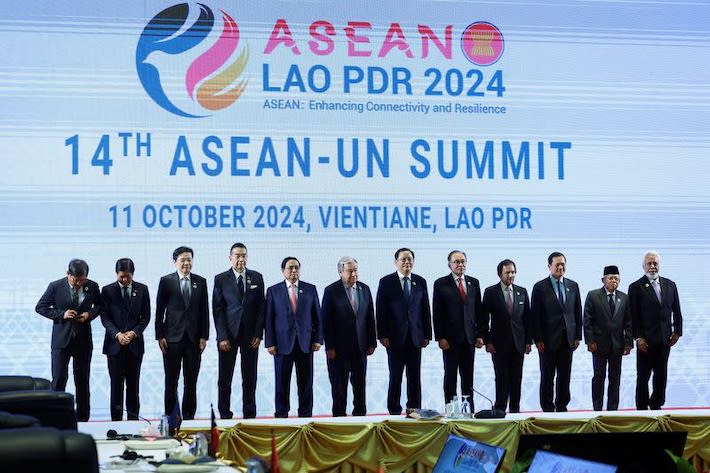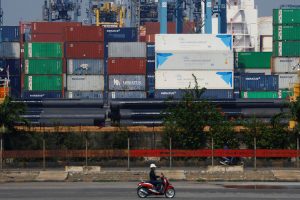Southeast Asian leaders have called for swift outcomes to try to end two crises that have plagued the region in recent years – the civil war in Myanmar and escalating tensions in the South China Sea.
Leaders of the 10 ASEAN states gathered in Vientiane, the capital of Laos, late last week along with the UN chief, plus diplomats from the US, Russia, China, Japan, India, South Korea and Australia, for their annual summit, but there is considerable doubt, once again, that their latest efforts will yield much fruit.
Analysts say any agreement on a code of conduct for the South China Sea based on international law will depend on Beijing – which has resisted a conclusive agreement for over two decades, and that the senior general in Naypyidaw is unlikely to agree to an immediate halt to fighting in Myanmar, let alone inclusive peace talks to end its civil war.
ALSO SEE: EU Warns ‘China Must Adapt’ to Resolve Trade Disputes
Confrontations have been rising in disputed waters of the South China Sea between China, which claims sovereignty over almost all the vital waterway, and ASEAN members including the Philippines and more recently Vietnam.
The rows have raised risks of an escalation that could eventually involve the United States, which is bound by treaty to defend the Philippines if it is attacked.
The sea, where $3 trillion worth of trade passes annually, was been a major point of contention at the ASEAN meetings. China and Russia, in particular, continue to object to a reference to the 1982 UN Convention on the Law of the Sea, a US official said on Saturday.
The ASEAN statement called for confidence-building measures that could “reduce tensions and the risk of accidents, misunderstandings and miscalculation” in the South China Sea.
It cited “positive momentum” in talks on a maritime code that could help settle disputes. China and ASEAN agreed on this in 2002, but the formal process of creating one did not start until 2017.
The bloc “looked forward to the early conclusion of an effective and substantive” code of conduct that is “in accordance with international law”, including the UN convention, the statement said.
ASEAN seeks immediate end to Myanmar war
On Myanmar’s spiralling war, ASEAN called for “an immediate cessation” of violence and the creation of a “conducive environment for the delivery of humanitarian assistance and inclusive national dialogue” that is “Myanmar-owned and -led”.
The war between ASEAN member Myanmar’s military government and an expanding armed resistance is a major concern for the bloc, which has made little progress on a five-point peace plan, unveiled months after the 2021 coup that brought the junta to power.
Some 18.6 million people – more than a third of Myanmar’s population – are estimated to be in need of humanitarian assistance.
But ASEAN welcomed Thailand’s initiative to host informal talks on Myanmar, possibly joined by other ASEAN members, later this year.
US says Russia, China blocked Asia leaders’ statement
Russia and China blocked a proposed consensus statement for the East Asia Summit drafted by Southeast Asian countries, mainly over objections to language on the contested South China Sea, a US official told Reuters on Saturday.
A draft statement arrived at by consensus by ASEAN officials was put to the 18-nation East Asia Summit meeting in Laos on Thursday evening, the official said.
“ASEAN presented this final draft and said that, essentially, this was a take-it-or-leave-it draft,” the official said on condition of anonymity.
The US, Japan, Australia, South Korea and India all said they could support it, the official said, adding: “The Russians and the Chinese said that they could not and would not proceed with a statement.”
Russian Foreign Minister Sergei Lavrov told a news conference in Vientiane on Friday the final declaration had not been adopted because of “persistent attempts by the United States, Japan, South Korea, Australia and New Zealand to turn it into a purely political statement.”
China’s Washington embassy did not immediately respond to a request for comment.
The US official said there were a couple of issues of contention, but the key one was how it referred to the UN Convention on the Law of the Sea (UNCLOS), going further than in the previous 2023 EAS statement.
But the official said, “there was certainly no language that was getting into the nitty gritty of any particular standoff, no language that was favoring any claimant over any other.”
China claims nearly all of the South China Sea and has stepped up pressure on rival claimants, notably the Philippines. ASEAN has spent years negotiating a Code of Conduct with Beijing for the strategic waterway, with some ASEAN states insisting it be based on UNCLOS.
China says it backs a code, but does not recognize a 2016 arbitral ruling that said its claim to most of the South China Sea had no basis under UNCLOS, to which Beijing is a signatory.
According to a draft seen by Reuters, the proposed EAS statement contained an extra sub-clause over the 2023 approved statement, and this was not agreed to. It noted a 2023 UN resolution saying that UNCLOS “sets out the legal framework within which all activities in the oceans and seas must be carried out.”
Another sub-clause not agreed said the international environment, including “in the South China Sea, the Korean Peninsula, Myanmar, Ukraine and the Middle East … present challenges for the region.”
Chinese Premier Li Qiang told the summit Beijing was committed to UNCLOS and striving for an early conclusion of a Code of Conduct, while stressing its claims have solid historical and legal grounds.
- Jim Pollard with Reuters
ALSO SEE:
Foreign Investment in ASEAN Tops China For First Time in Decade
Rush for Thailand’s $14-Billion Handout Scheme Hit by Glitches
New US Chip Equipment Export Rule to Hit Taiwan, ASEAN States
Solar Overcapacity Kills Projects, Fuels Bankruptcies In China
Vietnam Enjoys Big Jump in Exports, Industrial Production
Thai Economy Rocked by Factory Closures, Cheap Chinese Imports
Chinese Firms Seek Malaysian Help to Avoid US Tariffs: FT
China Signs $2.8bn Deals in Malaysia, Eyes Pan SE Asia Rail Link
























